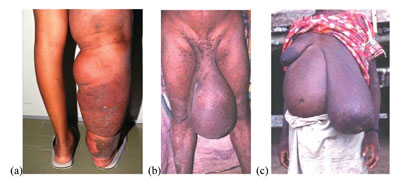Clinical manifestations of lymphatic filariasis
The clinical manifestations of the disease are as a result of the inflammation and damage to the lymphatic vessels caused by the person's own immune response trying to reject the worms, and when vessels become blocked by clusters of worms.
The overall effect is to disrupt the lymphatic system, which normally collects tissue fluids draining from the body's cells and returns the fluid to the blood stream. If the lymphatic drainage is blocked, the lower limbs and sometimes also the genitals become hugely swollen with fluid – a condition called lymphoedema (pronounced 'limf-ee-deem-ah').
Most infections do not produce symptoms, but in people where the lymphatic drainage is badly damaged the common symptoms include hydrocele (swelling of the scrotum, pronounced 'hy-droh-seel'), swelling of the legs and feet, and thickening of the skin into folds (figure below).
Infection of the swollen skin folds by bacteria is a frequent cause of very painful attacks. Patients suffer from episodes of fever and around 40% develop kidney damage.
